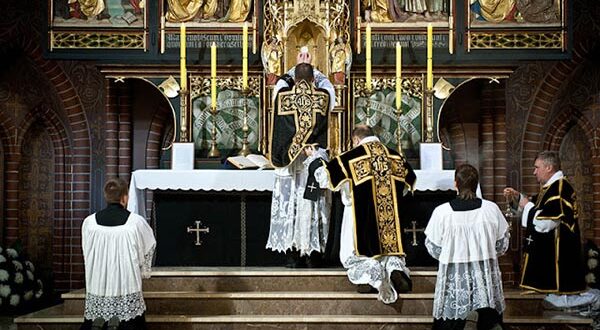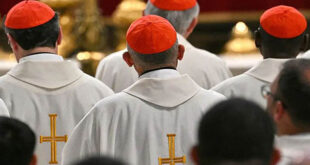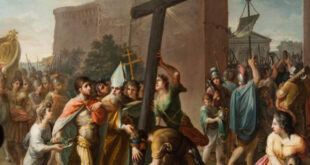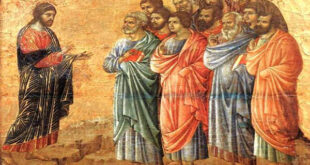Introduction: The Absence of the Sacred
If we enter many churches today, we find a friendly and welcoming atmosphere. The lights shine warmly, the music is accessible, and the words spoken from the altar seek closeness and immediate understanding. However, something seems to have faded away: the sense of the sacred, the imposing presence that shakes the soul. The mysterium tremendum et fascinans, that experience of the divine that inspires reverence and awe, which was once essential in the traditional liturgy, has been diluted.
The sense of the sacred in Catholic liturgy has always oscillated between attraction and trembling, proximity and distance. However, in recent times, the balance seems to have drastically tilted towards closeness, leaving aside the tremendum—the perception of the divine mystery that overwhelms us. How did we get here? Why is it important to recover this dimension?
The “Tremendum”: Reverent Fear Before God
The term mysterium tremendum was coined by Lutheran theologian Rudolf Otto in his work The Idea of the Holy (1917). He used this expression to describe man’s reaction to the divine: a feeling of reverent fear, awe, and admiration before God’s infinite majesty.
This idea is not new. In Sacred Scripture, we find multiple examples of this reverential fear:
- Moses covering his face before the burning bush because “he was afraid to look at God” (Exodus 3:6).
- Isaiah trembling in the presence of the Lord: “Woe is me, for I am lost!” (Isaiah 6:5).
- The Apostles falling to the ground on Mount Tabor before the glory of the Transfigured Christ (Matthew 17:6).
- St. John in the Book of Revelation, falling as though dead before the vision of the glorified Christ (Revelation 1:17).
The Church, aware of this reality, translated this reverence into the liturgical realm. For centuries, Catholic liturgy was imbued with signs that evoked the tremendum:
- The imposing architecture of churches, elevating the gaze towards the transcendent.
- Latin as a sacred language, distinct from everyday speech.
- Gregorian chant, which transports the soul to prayer.
- Silent adoration, allowing for a personal encounter with God.
- The priest’s ad orientem posture, guiding the people towards God.
These elements communicated that what was happening at Mass was not merely a social gathering but a supernatural event: the unbloody renewal of Christ’s Sacrifice on Calvary.
Liturgical Change and the Loss of the Tremendum
With the liturgical reform following the Second Vatican Council, there was a shift towards a more accessible and participatory liturgy. While the desire to bring the people closer to the Eucharistic Mystery was legitimate, in many cases, it resulted in a simplification that ultimately eliminated the sense of the sacred.
Some of the changes that affected the perception of the tremendum were:
- The Disappearance of Latin: The exclusive use of vernacular languages facilitated understanding but lost the sacred character of the liturgy. Latin acted as a veil, reminding us that we are addressing God, not merely engaging in human dialogue.
- The Abandonment of Sacred Silence: The traditional Mass had moments of deep silence, especially during the Canon. Today, in many liturgies, noise is constant—dialogues, contemporary music, applause—making recollection difficult.
- The Altar Turned into a Communal Table: The priest stopped facing the Lord (ad orientem) and instead turned toward the congregation. This weakened the idea that the Mass is, above all, a sacrifice offered to God rather than just a fraternal banquet.
- The Elimination of Gestures of Reverence: Genuflections, incense, prostrations, and the use of the veil for women were reduced. With this, the attitude of adoration and respect for the Real Presence of Christ was diminished.
These changes were not doctrinally incorrect, but they had a profound impact on the perception of mystery. The result was a liturgy where closeness predominated over transcendence.
The Spiritual Consequences of Losing the Tremendum
When the sense of the sacred is diluted in the liturgy, the faith of the people also suffers. Some consequences of this loss include:
- A diminished sense of sin: If the liturgy no longer conveys the greatness of God, it will not highlight the gravity of sin and the need for conversion.
- A decline in belief in the Real Presence of Christ in the Eucharist: Recent studies show that many Catholics no longer believe in transubstantiation. If the liturgy does not communicate that something astonishing is happening at the altar, faith in this mystery weakens.
- The abandonment of Mass: If the liturgy is perceived as a human event rather than an encounter with the divine, many cease to see it as essential.
How Can We Recover the Tremendum in the Liturgy?
Despite the liturgical crisis, the Church still has the means to restore the sense of the sacred. Some practical ways to do this include:
- Revaluing Silence and Adoration: Promoting Eucharistic adoration and restoring moments of recollection in the Mass.
- Recovering Gestures of Reverence: Reinstituting genuflections, deep bows, and the reception of Communion on the tongue.
- Promoting the Traditional Liturgy or Faithful Reforms: Not necessarily returning to the Tridentine Rite for all, but restoring elements that highlight sacredness.
- Liturgical Formation for the Laity and Priests: Teaching the importance of mystery in the Mass and how to participate with devotion.
Conclusion: Rediscovering the Majestic Face of God
We cannot reduce the Mystery of God to mere closeness without awe. We need to rediscover the balance between familiarity with God and reverential fear. As Saint John Paul II said:
“We cannot lose the sense of wonder, the sacred stupor, the silent adoration before the Eucharistic mystery.”
Rediscovering the tremendum in the liturgy is neither nostalgia nor rigidity; it is an urgent necessity. The modern man, immersed in a noisy and banal world, needs to tremble once again before God’s greatness. The liturgy must be the place where heaven breaks into the earth, where the soul, in humility, exclaims:
“Lord, I am not worthy that You should enter under my roof, but only say the word, and my soul shall be healed.”






